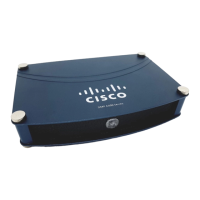14-2
User Guide for Cisco Digital Media Player Device Manager 5.2.x
OL-15764-03
Chapter 14 Configure Video and Audio Settings
Concepts
Understand Presentation Time Stamp (PTS) Values
Some of the metadata inside MPEG-2 files and streams is meant to ensure that:
• Video and audio data are synchronized correctly during playback.
• Playback occurs at the correct speed.
The metadata element that controls these behaviors is called the p
resentation time stamp, or PTS. The
original encoding of an MPEG-2 file automatically adds PTS metadata values to it. These values state
when a video or audio frame must be presented to the client system, relative to the timing of nearby
frames. So, in a typical MPEG-2 transport stream:
• Each video frame travels with one PTS value that describes it uniquely.
• Several audio frames travel together with one PTS value that describes them collectively.
Understand System Time Clock (STC) Values
When your DMP receives an MPEG-2 transport stream, it inspects the packets to find and make use of
PTS values within them. The first time that your DMP finds a PTS value in a transport stream, it
generates a system time clock (STC) value for its own use. Then, multiple events occur in tandem.
• Approximately 24 milliseconds after your DMP recognizes that the multicast stream has delivered
a PTS value, its generated STC value triggers playback of the corresponding video and audio data.
This brief delay contributes to proper playback of the stream.
• Your DMP considers the video frame rate and other factors to make programatic assumptions about
what the second PTS value will say and when it should arrive. Based on these assumptions, it
generates a second STC value. Your DMP repeats this process each subsequent time that it finds a
PTS value. It only ever discards a generated STC value when it learns that one of its assumptions
was wrong.
Understand Why PTS-STC Discrepencies Flood the Buffer and Cause Latency
If anything delays a PTS value from arriving when the corresponding STC value anticipates that it should
arrive, the visible result is latency during playback. This occurs because the jitter buffer must hold more
data than it is intended to hold.
Many factors might affect how “late” a PTS value can be, including network congestion, CPU load on
th
e DMP, and how the originating encoder is configured. For example, how does the encoder interleave
audio with video, and does it use B frames?
The arrival time for any PTS value can never be guaranteed, even in the best networks.
Guidelines
• Limit and Reduce Latency, page 14-2
Limit and Reduce Latency
You can reduce the risk of latency and limit its effects. Simply configure the originating encoder to:
• Use I frames and P frames only. It should not use B frames.
• Minimize the interleave time for audio and video.

